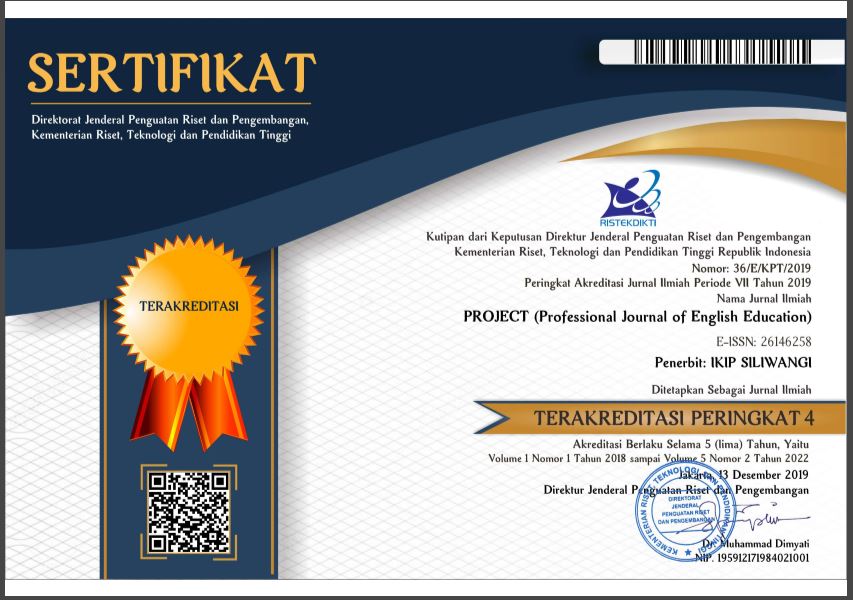STUDENTS’ SILENCE IN DIFFERENT EFL LEARNING PROCESSES AND THE PROLONGED EFFECTS: AN AUTOETHNOGRAPHY STUDY
Abstract
Students’ silence rapidly grows during online learning and continually affects the present learning process. Students showed various reasons for being silent. The study aims to determine students’ reasons for being silent in different EFL learning processes; online learning, limited face-to-face learning, and a whole class of face-to-face learning, and its prolonged effect on their learning behavior. The study used qualitative research with an autoethnography method. The study’s data was collected through observation, narrative journaling, and a semi-structured interview. The semi-structured interview was conducted with five sample students from five different classes, chosen purposively based on the researcher’s criteria. The finding shows that students are silent in online learning because the English learning process is not fun, they are afraid of making mistakes, and they cannot interact with the teacher and other friends. Students’ silence decreases when they have a limited class of face-to-face learning and almost entirely disappears during the whole class of face-to-face learning. However, students’ silence continued until the present EFL class, affecting their cognitive and social skills. Teachers need to apply appropriate teaching strategies to break students’ silence and improve their participation in the learning process.
References
Bahar, Purwati, O., & Setiawan, S. (2022). Exploring teacher power use and student silence in an EFL classroom: Evidence from Indonesia. Pegem Journal of Education and Instruction, 12(2), 157–165. https://doi.org/10.47750/pegegog.12.02.16
Bao, D. (2019). The place of silence in second language acquisition. English Language Teaching and Research Journal (ELTAR-J), 1(1), 26–42. https://doi.org/10.33474/eltar-j.v1i1.4771
Bao, D. (2021). Silence seen through different lenses. Journal of Silence Studies in Education, 1(1), 1–8.
Bhardwaj, P. (2019). Types of sampling in research. Journal of the Practice of Cardiovascular Sciences, 5(3), 157–163. https://doi.org/10.4103/jpcs.jpcs_62_19
Fan, H., Li, B., Pasaribu, T., & Chowdhury, R. (2023). Online interviews as new methodological normalcy and a space of ethics : An autoethnographic investigation into covid-19 educational research. Qualitative Inquiry. https://doi.org/10.1177/10778004231176283
Gangavarapu, S. L., Mutyala, U., & Chada, R. R. (2022). Investigating Indian ESL learners’ silent behaviour in response to oral tasks in online and offline classes. Journal of Silence Studies in Education, 1(2), 46–56. https://doi.org/10.31763/jsse.v1i2.24
Hanh, N. T. (2020). Silence is gold?: A study on students’ silence in EFL classrooms. International Journal of Higher Education, 9(4), 153–160. https://doi.org/10.5430/ijhe.v9n4p153
Hongboontri, C., Wittaya, I., & Boonyaprakob, K. (2021). Silence in an EFL Classroom: The interplay of Schwab’s four commonplaces. Suranaree Journal of Social Science, 15(1), 128–146.
Hu, J. (2021). Toward the role of EFL/ESL students’ silence as a facilitative element in their success. Frontiers in Psychology, 12(737123), 1–4. https://doi.org/10.3389/fpsyg.2021.737123
Huynh, H.-H., & Adams, M. (2022). Vietnamese teacher educators’ perceptions of silence during online English as a Foreign Language classes. Journal of Silence Studies in Education, 1(2), 57–69. https://doi.org/10.31763/jsse.v1i2.10
Kandilla, D. P., Dewi, N. S. N., & Pujasari, R. S. (2021). Teacher’s perception of students’ silence in EFL classroom: A case study. Teaching & Learning English in Multicultural Contexts (TLEMC), 5(1), 20–34. http://jurnal.unsil.ac.id/index.php/tlemc/index
Karas, M., & Uchihara, T. (2021). Silence: A duoethnography. Journal of Silence Studies in Education, 1(1), 64–75. https://doi.org/10.31763/jsse.v1i1.5
Maher, K., & King, J. (2020). Observing anxiety in the foreign language classroom: Student silence and nonverbal cues. Journal for the Psychology of Language Learning, 2(1), 116–141. https://doi.org/10.52598/jpll/2/1/6
Nurrohmah, Z. Q. A., & Waloyo, A. A. (2021). The correlation between silence phenomenon and EFL student online class. English Learning Innovation, 2(2), 62–74. https://doi.org/10.22219/englie.v2i2.17736
Perkasa, A. B., Savitri, D., & Yogyantoro, Y. (2022). Anxiety-related silence in speaking among Indonesian EFL junior high school students. Ahmad Dahlan Journal of English Studies, 9(2), 47–63. https://doi.org/10.26555/adjes.v9i2.145
Rinehart, R. E., & Earl, K. (2016). Auto-, duo- and collaborative-ethnographies: “caring” in an audit culture climate. Qualitative Research Journal, 16(3), 210–224. https://doi.org/10.1108/QRJ-04-2016-0024
Singh, N. (2011). Student-centered learning (SCL) in classrooms — A comprehensive overview. Educational Quest, 2(2), 275–282.
Weimer, M. (2002). Learner-centered teaching: Five key changes to practice. Jossey-Bass A Wiley Imprint.
Zafarina, N. F. (2022). Silent learners’ voices: Exploring the silence behavior in Indonesian EFL Classroom. Journal of English Language Teaching and Linguistics, 7(2), 349–363. https://doi.org/10.21462/jeltl.v7i2.846
Downloads
Published
Issue
Section
License
Copyright (c) 2023 PROJECT (Professional Journal of English Education)

This work is licensed under a Creative Commons Attribution-ShareAlike 4.0 International License.




